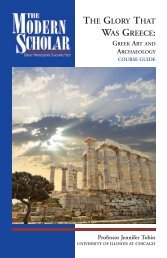The Trojan War in Homer and History - Recorded Books
The Trojan War in Homer and History - Recorded Books
The Trojan War in Homer and History - Recorded Books
You also want an ePaper? Increase the reach of your titles
YUMPU automatically turns print PDFs into web optimized ePapers that Google loves.
LECTURE SEVEN<br />
This is extremely important, because if the Mycenaeans can be equated with<br />
the Ahhiyawans (Ahhiyawa = Achaia = Achaeans = Mycenaeans), then there<br />
is substantial textual evidence for contact between the Hittites <strong>and</strong> the<br />
Mycenaeans throughout the course of the Late Bronze Age. If the<br />
Mycenaeans are not the Ahhiyawans, then they are never mentioned by the<br />
Hittites. <strong>The</strong> argument most frequently used today is that Ahhiyawa must,<br />
almost by default, be a reference to the homel<strong>and</strong> of the Mycenaeans, for we<br />
have, on the one h<strong>and</strong>, an important Late Bronze Age culture <strong>and</strong> civilization<br />
otherwise unmentioned <strong>in</strong> the Hittite texts (the Mycenaeans) <strong>and</strong>, on the<br />
other h<strong>and</strong>, an important textually attested Late Bronze Age “state” without<br />
archaeological rema<strong>in</strong>s (Ahhiyawa). It seems most reasonable to equate the<br />
two. Although locations for Ahhiyawa have been sought <strong>in</strong> Thrace, on<br />
Rhodes, on the western coast of Anatolia, <strong>and</strong> on the Greek Ma<strong>in</strong>l<strong>and</strong>, it<br />
seems most logical that Ahhiyawa <strong>and</strong> the Ahhiyawans of the Hittite texts are<br />
a reference to the ma<strong>in</strong>l<strong>and</strong> of Greece <strong>and</strong> to the Mycenaeans.<br />
So then, here <strong>in</strong> Hittite annals <strong>and</strong> a bronze Mycenaean sword, we may well<br />
meet the Achaeans who, accord<strong>in</strong>g to <strong>Homer</strong>, crossed the Aegean <strong>and</strong><br />
fought at the city of Troy. However, this event was apparently two hundred<br />
years before <strong>Homer</strong>’s <strong>Trojan</strong> <strong>War</strong> . . . <strong>and</strong> the evidence suggests that <strong>in</strong> this<br />
conflict the Mycenaeans <strong>and</strong> the <strong>Trojan</strong>s were allies, not enemies, fight<strong>in</strong>g<br />
together aga<strong>in</strong>st the Hittites. Confus<strong>in</strong>g as this may seem, it leads to an<br />
<strong>in</strong>trigu<strong>in</strong>g suggestion that the <strong>Trojan</strong> <strong>War</strong> may not have been simply a onetime<br />
conflagration; <strong>in</strong>stead, it might have been the consummation of centuries-long<br />
contacts—sometimes friendly, sometimes hostile—between<br />
Mycenaean <strong>and</strong> <strong>Trojan</strong> peoples, which <strong>Homer</strong> then telescoped <strong>in</strong>to a s<strong>in</strong>gle,<br />
ten-year-long battle fought for Helen.<br />
<strong>The</strong>re are, to date, some twenty-six Hittite texts that mention Ahhiyawa or<br />
Ahhiyawans, from the time of Tudhaliya I/II <strong>in</strong> the fifteenth century BCE until<br />
the time of Tudhaliya IV <strong>in</strong> the thirteenth century BCE. <strong>The</strong>se Ahhiyawa texts<br />
document dist<strong>in</strong>ct, <strong>and</strong> often close, relations between the Mycenaeans <strong>and</strong><br />
the native residents of Arzawa, A v<br />
s v<br />
suwa, the Seha River L<strong>and</strong>, <strong>and</strong> other<br />
regions <strong>in</strong> western Anatolia, but they also document the fact that it was<br />
apparently the policy of Ahhiyawa to actively support prom<strong>in</strong>ent dissidents<br />
aga<strong>in</strong>st Hittite authority <strong>in</strong> these regions of western Anatolia <strong>and</strong> to encourage<br />
the anti-Hittite activities of these people. <strong>The</strong> Ahhiyawa texts also document<br />
the fact that Mycenaean relations with the Hittites were sometimes friendly<br />
<strong>and</strong> sometimes hostile over the course of these three centuries.<br />
Of particular <strong>in</strong>terest is a text from Tudhaliya IV’s reign (1227–1209 BCE): a<br />
treaty drawn up between the Hittites <strong>and</strong> Sausgamuwa, the ruler of Amurru, a<br />
small k<strong>in</strong>gdom on the coast of North Syria. <strong>The</strong> treaty is primarily concerned<br />
with prohibit<strong>in</strong>g trade with Assyria, with whom the Hittites were then at war. <strong>The</strong><br />
most <strong>in</strong>terest<strong>in</strong>g part of the so-called Sausgamuwa Treaty, however, has to do,<br />
once aga<strong>in</strong>, with those pesky Ahhiyawans—or Mycenaeans/Achaeans—whom<br />
Tudhaliya IV’s ancestor, namely the above Tudhaliya I/II, had defeated <strong>in</strong> the<br />
Assuwa Rebellion two hundred years earlier.<br />
In the treaty, Tudhaliya IV places an embargo on trade between Ahhiyawa<br />
<strong>and</strong> Assyria, say<strong>in</strong>g, “let no ship of Ahhiyawa go to him [Assyria].” That this is<br />
a directive aimed at stopp<strong>in</strong>g Mycenaean ships from reach<strong>in</strong>g Assyria is the<br />
32






